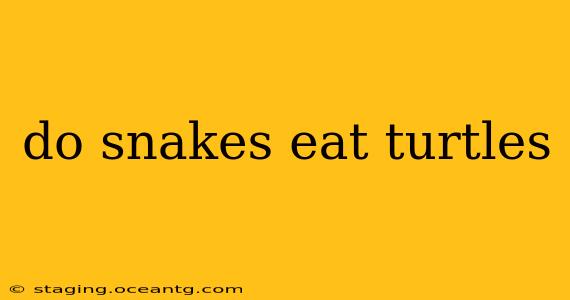Do Snakes Eat Turtles? A Deep Dive into Predatory Behavior
The question of whether snakes eat turtles is a fascinating one, leading us into the complex world of predator-prey relationships. The simple answer is: yes, some snakes do eat turtles, but it's not a universal phenomenon. Several factors determine whether a snake will prey on a turtle, including the snake's size and species, the turtle's size and species, and the availability of other food sources.
Let's explore this intriguing interaction further.
What Types of Snakes Eat Turtles?
Several snake species are known to consume turtles, with larger constrictors being the most common culprits. These snakes often rely on their strength and constriction to subdue their shelled prey. Examples include:
-
Large constrictors: Species like the python family (including Burmese pythons and reticulated pythons) and boas (such as the emerald tree boa, although they generally prefer smaller prey) are capable of consuming turtles, particularly smaller ones or those with weaker shells. Their powerful muscles allow them to crush the turtle's shell or simply overpower it.
-
Hognose snakes: While known for their bluff displays, certain hognose species have been observed eating turtles, particularly hatchlings or smaller, more vulnerable turtles. They use their powerful jaws and venom (though not lethal to humans) to subdue their prey.
What Kind of Turtles Do Snakes Eat?
The size and type of turtle significantly impact whether it becomes snake prey. Smaller turtles, like hatchlings or young individuals of various species, are more vulnerable to snake predation. Even larger turtles aren't entirely safe, though, especially if they are weakened or ill. Snakes rarely attack adult turtles with strong shells unless they are exceptionally large or the turtle is somehow incapacitated. Certain turtle species with thinner shells might also be more susceptible.
How Do Snakes Eat Turtles?
The method a snake employs to consume a turtle depends on its size and the turtle's size. Larger constrictors will often crush the turtle's shell by squeezing it tightly, weakening it enough to break or access softer parts. Some snakes might use their powerful jaws to pry the shell open, while others may wait for a turtle that is already deceased or injured, thus limiting the risk of a struggle.
What are the most common prey for snakes?
While turtles can certainly be on the menu for some snakes, it's crucial to remember that their diet is quite diverse. Most snakes primarily eat rodents, small mammals, birds, eggs, lizards, frogs, and fish. The consumption of turtles is often opportunistic and depends on their availability and the size and strength of the snake.
Do all snakes eat turtles?
No, absolutely not. The vast majority of snake species do not include turtles in their diet. Many snakes are far too small to tackle even the smallest turtle, while others have specialized diets that don't involve shelled reptiles.
Can snakes break a turtle's shell?
While some snakes possess the strength to crush a turtle's shell, this isn't always successful. The turtle's shell provides significant protection, and the success of the snake depends heavily on the size and species of both the snake and the turtle. Smaller turtles are much more vulnerable than larger ones with thicker shells.
In conclusion, while certain snake species are capable of eating turtles, it's not a common occurrence. The interaction is heavily dependent on the size and species of both predator and prey, and turtles are far from a staple in most snake diets. Understanding this complex interplay highlights the intricate dynamics within ecological systems.
